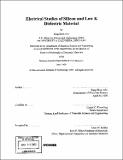Electrical studies of silicon and low K dielectric material
Author(s)
Ahn, Sang Hoon, 1970-
DownloadFull printable version (6.815Mb)
Other Contributors
Massachusetts Institute of Technology. Dept. of Materials Science and Engineering.
Advisor
Lionel C. Kimerling.
Terms of use
Metadata
Show full item recordAbstract
Junction capacitance measurement is a well-established powerful characterization technique that allows one to explore electrical and physical properties of defects in bulk and interface of electronic materials. Capacitance-Voltage (CV) measures the overall net carrier concentration and a built-in voltage for a diode junction. Deep level transient spectroscopy (DLTS) as one of the most sensitive electrical measurement techniques can detect electrically active impurity concentration on the level of 10-1 to 10-5 of substrate doping concentration. The characteristic energy level and capture cross-section of the traps in the semiconductor energy gap can be extracted from DLTS temperature scans. Coupled with CV free carrier concentration profile, isothermal profiling by DLTS can determine the distribution of electrically active defects in the semiconductor. CV can also measure dielectric constant, K, on a metal-oxide-silicon structure. In this thesis, the junction capacitance technique is a primary tool used to study Er, Fe, and Mo in silicon. Si:5r is a candidate system for a light emitter in Si-based microphotonics. Fe is one of the most troublesome elements that degrade integrated circuit performance and solar cell efficiency. Mo is a fairly unknown contaminant typical of integrated circuit processing. Fluorosilicate glass is being used as a dielectric material for inter-metal levels in the current generation microprocessor. By measuring the reaction kinetics of the Er-related donor state, a defect structure for Si:Er light emitter center was deduced. The role of heterogeneous precipitation in Fe internal gettering was observed and modeled by measurement of residual [FeB] associates following [Fe] saturation, quench, and annealing processing. The diffusivity of Mo was determined and models for both the substitutional and the kick out diffusion mechanism were constructed. Finally, a predictive model for the F-content dependent dielectric constant variation of Si02 was established.
Description
Thesis (Ph.D.)--Massachusetts Institute of Technology, Dept. of Materials Science and Engineering, 1999. Includes bibliographical references (leaves 108-111).
Date issued
1999Department
Massachusetts Institute of Technology. Department of Materials Science and EngineeringPublisher
Massachusetts Institute of Technology
Keywords
Materials Science and Engineering.